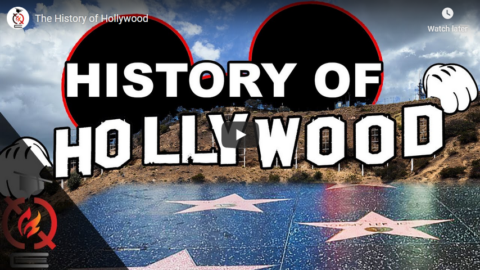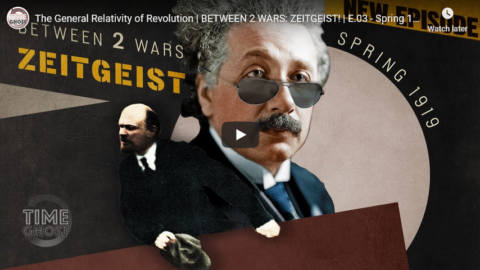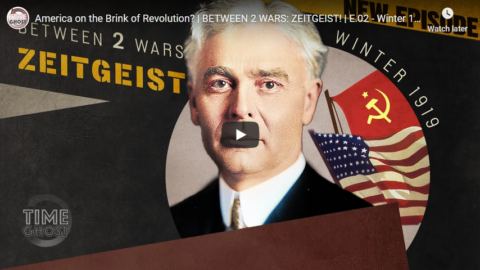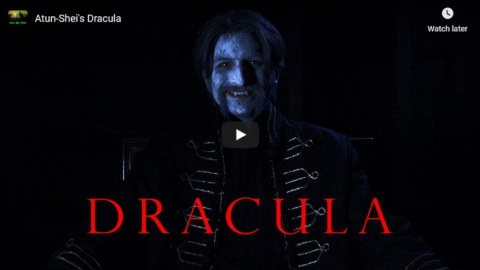The Cynical Historian
Published 3 Sep 2020This episode is about the history of Hollywood, and it’s quite a long one. This is part 9 in a long running series about California history.
————————————————————
references:
Bernard F. Dick, Engulfed: The Death of Paramount Pictures and the Birth of Corporate Hollywood (Lexington: The University Press of Kentucky, 2001). https://amzn.to/3f2Yb0SHollywood’s America: United States History Through its Films, eds. Mintz, Steven and Randy Roberts (St. James, N.York: Brandywine Press, 1993). https://amzn.to/2tZIoJT
Richard Slotkin, Gunfighter Nation: The Myth of the Frontier in Twentieth-Century America (New York: Atheneum Books, 1992). https://amzn.to/2KX0jI2
Kevin Starr, Inventing the Dream: California through the Progressive Era, (Oxford, U.K.: Oxford University Press, 1985). https://amzn.to/2VPTbVX
————————————————————
Support the channel through PATREON: https://www.patreon.com/CynicalHistorian
or by purchasing MERCH: teespring.com/stores/the-cynical-hist…LET’S CONNECT:
Twitch: https://www.twitch.tv/cynicalhistorian
Discord: https://discord.gg/Ukthk4U
Twitter: https://twitter.com/Cynical_History
Subreddit: https://www.reddit.com/r/CynicalHistory/————————————————————
Wiki: By 1912, major motion-picture companies had set up production near or in Los Angeles. In the early 1900s, most motion picture patents were held by Thomas Edison’s Motion Picture Patents Company in New Jersey, and filmmakers were often sued to stop their productions. To escape this, filmmakers began moving out west to Los Angeles, where attempts to enforce Edison’s patents were easier to evade. Also, the weather was ideal and there was quick access to various settings. Los Angeles became the capital of the film industry in the United States. The mountains, plains and low land prices made Hollywood a good place to establish film studios.
Director D. W. Griffith was the first to make a motion picture in Hollywood. His 17-minute short film In Old California (1910) was filmed for the Biograph Company. Although Hollywood banned movie theaters — of which it had none — before annexation that year, Los Angeles had no such restriction. The first film by a Hollywood studio, Nestor Motion Picture Company, was shot on October 26, 1911. The H. J. Whitley home was used as its set, and the unnamed movie was filmed in the middle of their groves at the corner of Whitley Avenue and Hollywood Boulevard.
The first studio in Hollywood, the Nestor Company, was established by the New Jersey–based Centaur Company in a roadhouse at 6121 Sunset Boulevard (the corner of Gower), in October 1911. Four major film companies – Paramount, Warner Bros., RKO, and Columbia – had studios in Hollywood, as did several minor companies and rental studios. In the 1920s, Hollywood was the fifth-largest industry in the nation. By the 1930s, Hollywood studios became fully vertically integrated, as production, distribution and exhibition was controlled by these companies, enabling Hollywood to produce 600 films per year.
Hollywood became known as Tinseltown and the “dream factory” because of the glittering image of the movie industry. Hollywood has since become a major center for film study in the United States.
————————————————————
Hashtags: #history #Hollywood #California
February 2, 2021
The History of Hollywood
QotD: Why “artistes” defended Roman Polanski before #MeToo
In 1977, Roman Polanski drugged, raped, and sodomized a 13-year-old girl. When he believed a sort-of-plea-bargain was about to come unstuck, he took it on the lam. He lived the high life in this self-imposed exile for thirty years, until busted in Switzerland recently. Now various of the usual suspects on the right wing’s enemies list are campaigning to block his extradition.
There’s a good deal of perplexity being expressed about this, and some predictable chuntering from right-wingers about lefties being moral degenerates. But this flap isn’t really about politics at all — it’s much simpler than that. It’s about people who think of themselves as “artistes” reserving themselves a get-out-of-jail card when they feel like behaving like repellent scum of the earth, too.
[…]
If you want to make that argument, Roman Polanski makes a great stake in the ground — not in spite of the heinousness of his crime, but because of it. If even a child-raper can invoke the all-purpose artiste excuse for scumminess, than the merely ordinary transgressions of artistes become trivia to be airily dismissed. And if the Polanski case becomes a “teachable moment” whereby people can be talked into feeling like boors or philistines for even thinking that artistes should be held to civilized standards of behavior, so much the better!
None of this is more than tenuously connected to leftism, and I have to say the the right-wing efforts to gin up indignation on that score sound quite contrived and stupid to me. This dispute isn’t about politics, it’s about privilege — not just whether Roman Polanski is above the law, but about whether his defenders can claim to be too.
Eric S. Raymond, “Why artists defend Roman Polanski”, Armed and Dangerous, 2009-09-29.
January 28, 2021
Blade Runner 1921?! – Robot Apocalypse Now | B2W: ZEITGEIST! | E.10 – Winter 1921
TimeGhost History
Published 27 Jan 20201Modern technology promises a lot, but it can also bring unprecedented horror. This season, the people of Czechoslovakia get to see that for themselves.
Join us on Patreon: https://www.patreon.com/TimeGhostHistory
Hosted by: Indy Neidell
Written by: Francis van Berkel
Director: Astrid Deinhard
Producers: Astrid Deinhard and Spartacus Olsson
Executive Producers: Astrid Deinhard, Indy Neidell, Spartacus Olsson, Bodo Rittenauer
Creative Producer: Maria Kyhle
Post-Production Director: Wieke Kapteijns
Research by: Francis van Berkel
Edited by: Michał Zbojna
Sound design: Marek KamińskiColorizations:
Daniel Weiss – https://www.facebook.com/TheYankeeCol…
Mikołaj Uchman
Norman Stewart – https://oldtimesincolor.blogspot.com/
Mikołaj Cackowski
KlimbimSources:
Some images from the Library of Congress
Bibliotheque nationale de FranceIcons from The Noun Project:
– noun_Sound_3530255
– Microphone by Agung Cahyo sSoundtracks from Epidemic Sound:
“Epic Adventure Theme 3” – Håkan Eriksson
“I Am Unbreakable” – Niklas Johansson
“Waiting like the Storm” – Rand Aldo
“Le Chat Noir 1” – Martin Landh
“A Single Grain Of Rice” – Yi Nantiro
“Alleys of Buenos Aires” – Tiki Tiki
“Age Of Men” – Jo WandriniArchive by Screenocean/Reuters https://www.screenocean.com.
A TimeGhost chronological documentary produced by OnLion Entertainment GmbH.
From the comments:
TimeGhost History
1 day ago (edited)
Episode 10 of the series and for the first time we’re looking at a decidedly negative outcome that people imagined might come with further technological progress. Over 100 years later and it’s still something people are fearful of, and it often feels like Artificial Intelligence providing a real threat to humanity’s existence is just around the corner.We’d be interested to know what you guys all think. Is there a chance that something along the lines of what Čapek imagined actually happening? Let us know in the comments.
NOTE: Unfortunately an error has snuck into this week’s episode. The portrait that is supposed to show Herbert Hoover is in fact of his son, Herbert Hoover Jr. We are working on getting this fixed as fast as possible, and we apologize for the inconvenience in the meantime.
January 14, 2021
Frankenstein and the Socialist Origins of Electronic Music | B2W: ZEITGEIST! | E.09 – Harvest 1920
TimeGhost History
Published 13 Jan 2021There is a surprising connection between sci-fi films and the technological policies of Soviet Russia. Watch to find out …
Join us on Patreon: https://www.patreon.com/TimeGhostHistory
Hosted by: Indy Neidell
Written by: Indy Neidell and Francis van Berkel
Director: Astrid Deinhard
Producers: Astrid Deinhard and Spartacus Olsson
Executive Producers: Astrid Deinhard, Indy Neidell, Spartacus Olsson, Bodo Rittenauer
Creative Producer: Maria Kyhle
Post-Production Director: Wieke Kapteijns
Research by: Indy Neidell and Francis van Berkel
Image Research by: Daniel Weiss
Edited by: Daniel Weiss
Sound design: Marek KamińskiColorizations:
Daniel Weiss – https://www.facebook.com/TheYankeeCol…Sources:
Some images from the Library of CongressFrom the Noun Project:
– Mansion By Shane Stieben
– signal by Adrien Coquet
– cowboy man by Adrien Coquet
– signal by Adrien Coquet
– room By Batibull, ESSoundtracks from Epidemic Sound
– “One More for the Road” – Golden Age Radio
– “Dark Shadow” – Etienne Roussel
– “The Inspector 4” – Johannes Bornlöf
– “The Inspector” – David Celeste
– “Wind Chimes” – Farrell Wooten
– “Last Point of Safe Return” – Fabien Tell
– “Puzzle Of Complexity” – Jo Wandrini
– “What Now” – Golden Age Radio
– “Out the Window” – Wendel Scherer
– “Symphony of the Cold-Blooded” – Christian AndersenArchive by Screenocean/Reuters https://www.screenocean.com.
A TimeGhost chronological documentary produced by OnLion Entertainment GmbH.
December 29, 2020
QotD: Alfred Hitchcock’s The Birds
Electric Ghost Magazine: Your thesis that Hitchcock’s The Birds depicts recrudescent “angry nature” forcing civilization into regression is very pertinent at this particular time of COVID-19, as we make bunkers of our homes like those in the Brenner house against the birds. What does Hitchcock’s film teach us about our current moment?
Camille Paglia: The analogy to today’s global virus crisis is very compelling. The Birds demonstrates the fragility and folly of all human artifice. When omnipotent nature turns on mankind, everything falls to pieces — from protective dwellings to personal dignity and social cohesiveness. Unleashing the birds like a black plague, Hitchcock attacks the sentimental illusions that allow us to survive and thrive in our daily routines. The film has a metaphysical sweep, exposing the terrifying great unknowns at the heart of human existence.
As for the present time, Western developed nations have become too smugly complacent about their advanced technology and prosperity. Our electronic systems and intricate international supply and distribution network function so smoothly that they have become invisible to the affluent upper-middle-class, comfortably working from home via computer. These arrogant masters of the machine attribute all human ills to unjust society — from hurricanes to global warming, as if puny mankind is capable of such staggering power. Like Greek tragedy, The Birds shows the grim reality — human helplessness in the face of nature and fate, as commerce, schooling, hospitality, and the pretty dance of courtship are reduced to horror and squalor.
December 25, 2020
QotD: Christmas movies
Twas the night before Christmas and all through the house
Not a creature was stirring, not even a mouse…At which point, Sylvester the cat looks up from his long fruitless vigil outside the mouse hole in the baseboard and sighs with feeling to the narrator, “You’re not jutht whithlin’ Dickthie, brother.”
“Gift Wrapped” is like every Looney Tune or Merry Melody — a mere six minutes long. But with Christmas movies that’s a good thing. The western and the musical may be dead, but the charmless Xmas movie is now a genre all of its own and doing gangbusters. Do they teach it in film school? In fact, it’s really two genres: there are intentionally charmless Christmas movies like Bad Santa 2, and then the accidentally charmless ones, like that Ben Affleck flick where he’s some heartless yuppie who rents a bluecollar family for the holiday season so he can enjoy the authentic down-home Yule he’s never known. In such pictures, the great American Christmas, once the ne plus ultra of e pluribus unum, appears on celluloid an utterly exhausted seam.
So, besieged by such horrors, I thought I’d retreat to short-form holiday entertainment, or alternatively short-form holiday entertainment within long-form non-holiday fare. Any thirty seconds of “Gift Wrapped”, for example, is more rewarding than all three-and-a-half hours of Bad Santa 5 or whatever it is: six minutes of pure Looney Tunes pleasure in which Sylvester determines to land the only Christmas present he really wants — Tweety. The film opens with Granny slumbering upstairs and the impatient cat sneakily unwrapping his gift. It’s a rubber mouse and he’s not happy about it. “Why couldn’t I get thumthin’ practical?” he complains. “Like a real mouse.”
Mark Steyn, “A Frizzy Christmas”, Steyn Online, 2018-12-15.
December 23, 2020
No, Console Scalpers Aren’t Ruining Christmas
Foundation for Economic Education
Published 22 Dec 2020Support Out of Frame on Patreon: https://www.patreon.com/OutofFrameShow
Check out our podcast, Out of Frame: Behind the Scenes: https://www.youtube.com/channel/UCiS5…
As we enter peak holiday season, most people have their shopping done by now, but as always, many are scrambling last-minute for their purchases. And if you aren’t one of those early-birds fortunate enough to procure a PS5 or Xbox Series X, you can guarantee that you won’t be able to find one unless you’re willing to pay $1,200 to a scalper.
Many are understandably frustrated. How is it fair for people to buy up the consoles at $500 and sell for nearly double or triple the cost? “There ought to be a law” against that kind of thing — right?
Well, in short, there’s nothing wrong with scalping — and a few economic lessons will help explain why.
Scarcity is real and so is time-preference. Scalpers (and even bots) show that demand for some goods is so high that people are willing to pay several times the list price — which could provide a lot of information to Sony and Microsoft on how many consoles to produce and in what parts of the world. They could factor that information into the future, so there would be less problems with availability, but most retailers make this information exchange impossible.
______________________________
CREDITS:Produced by Sean W. Malone
Written by Jen Maffessanti & Sean W. Malone
Edited by Paul Nelson
Asst. Edited by Jason Reinhardt
December 18, 2020
When Movies Were Magic (3D glasses recommended)
Atun-Shei Films
Published 8 Sep 2020A brief history of early motion picture technology and artistry, from the magic lantern to Georges Méliès. Presented in glorious 3-D!!!
To fully enjoy this video, you will need a pair of red/blue anaglyph 3-D glasses. They can be acquired cheaply at a number of online vendors, and you can even make them at home by coloring sheets of clear plastic with permanent markers: https://www.wikihow.com/Make-Your-Own…
Support Atun-Shei Films on Patreon ► https://www.patreon.com/atunsheifilms
Leave a Tip via Paypal ► https://www.paypal.me/atunsheifilms (All donations made here will go toward the production of The Sudbury Devil, our historical feature film)
Buy Merch ► https://www.teespring.com/stores/atun…
#FilmHistory #MagicLantern #3D
Reddit ► https://www.reddit.com/r/atunsheifilms
Twitter ► https://twitter.com/atun_shei~REFERENCES~
[1] William Godwin. Lives of the Necromancers (1834). Project Gutenberg https://www.gutenberg.org/cache/epub/…
[2] Paul Clee. Before Hollywood: From Shadow Play to the Silver Screen (2005). Houghton Mifflin, Page 12-21
[3] Chris Bennett. “The Psychedelic Phantasmagoria Shows of the 18th Century” (2018). Cannabis Culture https://www.cannabisculture.com/conte…
[4] Clee, Page 39-47
[5] Clee, Page 84-85
[6] “Dissolving View Magic Lantern Slides.” Magic Lantern World https://magiclanternist.com/2016/09/2…
[7] “A Color Photograph Pioneer Comes to Light” (2018). The European Synchrotron https://www.esrf.eu/home/news/general…
[8] Clee, Page 83
[9] Clee, Page 85-95
[10] “Freeze Frame: Eadweard Muybridge’s Photography of Motion” (2000). National Museum of American History https://americanhistory.si.edu/muybri…
[11] “Sallie Garner at a Gallop.” IMDB https://www.imdb.com/title/tt2221420/…
[12] Laurent Mannoni. “Etienne-Jules Marey: French Physiologist and Chronophotographer.” Who’s Who of Victorian Cinema https://www.victorian-cinema.net/marey
[13] Clee, Page 107-109
[14] Harald Sack. “The Kinetoscope and Edison’s Wrong Way to Invent the Cinema” (2020). SciHi Blog http://scihi.org/kinetoscope-edison/
[15] Clee, Page 127
[16] Clee, Page 139-141
[17] James Travers. “Georges Méliés Biography: Life and Films” (2017). FrenchFilms.org http://www.frenchfilms.org/biography/…
[18] Clee, Page 158-159
November 21, 2020
About that “Canadian content crisis” the feds are trying to “fix” with Bill C-10
Michael Geist begins a series of posts on the ongoing blunder that is the federal government’s “get money from the web giants” proposed legislation:
Canadian Heritage Minister Steven Guilbeault rose in the House of Commons yesterday for the second reading of Bill C-10, his Internet regulation bill that reforms the Broadcasting Act. Guilbeault told the House that the bill would level the playing field, that it would establish a high revenue threshold before applying to Internet streamers, would not impact consumer choice, or raise consumer costs. He argued that even if you don’t believe in cultural sovereignty, you should still support his bill for the economic benefits it will bring, warning that Canadian producers will miss out on a billion dollars by 2023 if the legislation isn’t enacted. He painted a picture of Internet companies (invariably called “web giants”) that have millions of Canadian subscribers but do not contribute to the Canadian economy.
Guilbeault is wrong. He is wrong in his description of the bill (it does not contain thresholds), wrong about its impact on consumers (it is virtually certain to both decrease choice and increase costs), wrong about the contributions of Internet streamers (who have been described as the biggest contributor to Canadian production), wrong about level playing field claims (incumbent broadcasters enjoy a host of regulatory benefits not enjoyed by streamers), wrong about the economic impact of the bill (it is likely to decrease investment in the short term), and wrong about cultural sovereignty (it surrenders cultural sovereignty rather than protect it).
With the bill starting its Parliamentary review, this is the first in a new series of posts on why a careful examination of the data and the bill itself reveals multiple blunders. There are good arguments for addressing the sector, including tax reform, privacy upgrades, and competition law enforcement. There are also benefits to updating the Broadcasting Act, but in an effort to cater to a handful of vocal lobby groups over the interests of the broader Canadian public, Guilbeault’s bill will cause more harm than good. The series will run each weekday for the next month, first addressing the weak policy foundation that underlies Bill C-10, then a series a posts on the uncertainty the bill creates, a review of the trade threats it invites, and an assessment of its likely impact on consumers and the broader public.
The series begins with a post on the fictional Canadian content “crisis.” Canadians can be forgiven for thinking that the shift to digital and Internet streaming services has created a crisis on creating Canadian content. Canadian cultural lobby groups regularly claim that there is one (Artisti, CDCE) and Guilbeault tells the House of Commons that billions of dollars for the sector is at risk. Yet the reality is that spending on film and television production in Canada is at record highs. This includes both certified Canadian content and so-called foreign location and service production in which the production takes place in Canada (thereby facilitating significant economic benefits) but does not meet the narrow criteria to qualify as “Canadian.” I have written before about the need to revisit the Canadian content qualification rules which enable productions with little connection to Canada to receive certification and some that directly meet the goal of “telling Canadian stories” that fail to do so.
November 19, 2020
White Lives Matter More – A Summer of Blood | BETWEEN 2 WARS: ZEITGEIST! | E.04 – Summer 1919
TimeGhost History
Published 18 Nov 2020Technology promises a better and more connected world in the summer of 1919. But battles still rage everywhere over who will inherit it.
Join us on Patreon: https://www.patreon.com/TimeGhostHistory
Subscribe to our World War Two series: https://www.youtube.com/c/worldwartwo…
Like TimeGhost on Facebook: https://www.facebook.com/TimeGhost-16…Hosted by: Indy Neidell
Written by: Indy Neidell and Francis van Berkel
Director: Astrid Deinhard
Producers: Astrid Deinhard and Spartacus Olsson
Executive Producers: Astrid Deinhard, Indy Neidell, Spartacus Olsson, Bodo Rittenauer
Creative Producer: Maria Kyhle
Post-Production Director: Wieke Kapteijns
Research by: Indy Neidell and Francis van Berkel
Image Research by: Miki Cackowski and Michał Zbojna
Edited by: Michał Zbojna
Sound design: Marek KamińskiColorizations:
Mikołaj Uchman
Spartacus OlssonSources:
From the Noun Project: bridge by Adrien Coquet, Delete by Kevin Eichhorn, Fire by Sweet Farm, Model T by Alex Valdivia, people by Anastasia Latysheva, peoples by Musmellow, revolt by Symbolon, Smoke by Krish, people by Nithinan Tatah, explosion by Aldric RodríguezArchive by Screenocean/Reuters https://www.screenocean.com.
A TimeGhost chronological documentary produced by OnLion Entertainment GmbH.
From the comments:
TimeGhost History
21 hours ago
Four episodes into this new series and we think it’s going pretty well. Behind-the-scenes we have been getting ahead with our planning to make make things as laser-focused as possible and we have some pretty fascinating pieces of history we want to talk about.But we know that there is always a learning curve with a new series and we care what our community thinks. It’s the TimeGhost Army who make our content possible so we’d like to hear from you what you think about Season Two of Between 2 Wars. What are you enjoying about it? Is there anything you think we should work on? How do you feel about Indy’s outrageous suits and ties?
November 12, 2020
The General Relativity of Revolution | BETWEEN 2 WARS: ZEITGEIST! | E.03 – Spring 1919
TimeGhost History
Published 11 Nov 2020It is a springtime of revolution throughout the world in 1919 and not just the political kind. Era-defining advances in science and technology and iconic cinematography are made this season.
Join us on Patreon: https://www.patreon.com/TimeGhostHistory
Hosted by: Indy Neidell
Written by: Indy Neidell and Francis van Berkel
Director: Astrid Deinhard
Producers: Astrid Deinhard and Spartacus Olsson
Executive Producers: Astrid Deinhard, Indy Neidell, Spartacus Olsson, Bodo Rittenauer
Creative Producer: Maria Kyhle
Post-Production Director: Wieke Kapteijns
Research by: Indy Neidell and Francis van Berkel
Edited by: Michał Zbojna
Sound design: Marek KamińskiColorizations:
Klimbim
Mikołaj Uchman
Wayne Degan
metacolor.orgSources:
Library of Congress
Bundesarchiv
Icons from The Noun Project:
– retro computer By Tinashe Mugayi, MY
– audio sound recorder By Vectors Point, PK
– Radio by Bill Denk
– Old TV By Pascal Heß, DE
– Radio Tower by Iris SunSoundtracks from Epidemic Sound:
– “British Royalty” – Trailer Worx
– “Flight Path” – Cobby Costa
– “Deflection” – Reynard Seidel
– “Flight Path” – Cobby Costa
– “A Single Grain Of Rice” – Yi Nantiro
– “Trapped in a Maze” – Philip Ayers
– “Symphony of the Cold-Blooded” – Christian Andersen
– “Rainy Landscapes” – Farrell Wooten
– “Ancient Saga” – Max AnsonArchive by Screenocean/Reuters https://www.screenocean.com.
A TimeGhost chronological documentary produced by OnLion Entertainment GmbH.
From the comments:
TimeGhost History
1 day ago
J’accuse is one of the many iconic films we’ll explore in this series. The interwar period is when European cinema really starts to hit its stride again after some serious setbacks during the Great War. In those years, American cinema rocketed to the mainstream both at home and abroad, with revolutionary filmmaking techniques being developed that we still see today such as close-ups, huge cast lists, and realistic set design.The post-Great War is set to be a great era in the history of cinema and not just because of the films themselves, J’accuse and other films are important as historical movers in their own right! They shape public perceptions, influence political change, and inspire whole social movements, so make sure you stay tuned to find out.
And in the meantime, are there any iconic interwar films you think deserve to be in this series?
November 5, 2020
America on the Brink of Revolution? | BETWEEN 2 WARS: ZEITGEIST! | E.02 – Winter 1919
TimeGhost History
Published 4 Nov 2020There is revolution and fear of revolution throughout the world in the winter of 1919. But cultural and technological revolutions are also bringing hope to many. A new age of Jazz and Cinema is about to reach America and Europe.
Join us on Patreon: https://www.patreon.com/TimeGhostHistory
Hosted by: Indy Neidell
Written by: Indy Neidell, Francis van Berkel, and Spartacus Olsson.
Director: Astrid Deinhard
Producers: Astrid Deinhard and Spartacus Olsson
Executive Producers: Astrid Deinhard, Indy Neidell, Spartacus Olsson, Bodo Rittenauer
Creative Producer: Maria Kyhle
Post-Production Director: Wieke Kapteijns
Research by: Indy Neidell, Francis van Berkel, and Spartacus Olsson.
Archive Research: Daniel Weiss
Edited by: Daniel Weiss
Sound design: Marek KamińskiColorizations:
Daniel Weiss – https://www.facebook.com/TheYankeeCol…
Mikołaj Uchman
Norman Stewart – https://oldtimesincolor.blogspot.com/Sources:
From the Noun Project:
– Money by Gilberto
– lightbulb By Maxim KulikovSoundtracks from Epidemic Sound and ODJB:
– “One More for the Road” – Golden Age Radio
– “The Last Journey” – Line Neesgaard
– “Tiger_Rag” – ODJB
– “Not Safe Yet” – Gunnar Johnsen
– “Please Hear Me Out” – Philip Ayers
– “Dark Shadow” – Etienne Roussel
– “The Inspector 4” – Johannes Bornlöf
– “I Won’t Give You Up” – Almost Here
– “The Charleston” – Macy’s Voice
– “Defeated” – Wendel SchererArchive by Screenocean/Reuters https://www.screenocean.com.
A TimeGhost chronological documentary produced by OnLion Entertainment GmbH.
From the comments:
TimeGhost History
2 days ago (edited)
As in life, this series will always be a curious balance of light and dark. In the winter of 1919, one Parisian might have tickets to see the Original Dixieland Jass Band while their neighbour lies destitute after the war, and a well-to do man in Glasgow might be at the cinema while tanks rolls into his city to quell industrial unrest.Troubled and fascinating times then and troubled fascinating times now here in 2020. All of us here at TimeGhost hope that all of you are healthy and staying safe. And hey, if you need some entertainment to pass the time, you can find plenty of Between 2 Wars episodes alongside WW2 In Real Time and BIO Specials!
November 4, 2020
QotD: The dangers of breaking the “fourth wall”
Those are the givens. It doesn’t matter how ludicrous they are, so long as you don’t break your own rules.
Note that the rules can be broken from either side, the spectacle’s or the audience’s. Movies these days are most often guilty of the former, while rasslin’ bankrupted itself doing the latter. The last Star Wars movie I saw, for instance, was the first one with Girl Luke. It broke its own in-universe rules by having Girl Luke do everything Luke did, minus the training and effort and self doubt. She was just instantly awesome at everything, because grrrl power, and now that franchise is in the process of bankrupting (oh God, let it be so, and soon!) the entire Disney empire. Rasslin’ first tried to fool the “smart marks,” then went the nudge-nudge wink-wink route — both fatal to the suspension of disbelief for the majority of fans, who were still operating under the old contract.
Under the old contract, “wrestling fan,” like “Star Wars fan” or “Schwarzenegger movie fan” or what have you was a temporary identity. You went to the spectacle to put your real self aside for a few hours. You buy the ticket, and cease being Joe Schmoe the mechanic or the plumber or the customer service rep or the shmuck who still lives at home because he just can’t catch a break. Instead you’re transported to a galaxy far, far away, where bodybuilders are time-traveling robots and men in spandex come back from the dead to body slam their rivals.
For that kind of person, breaking the fourth wall, as the lit-crit types call it, is a slap in the face. Ha ha, fuck you, you loser! You don’t get to enjoy a few hours in a galaxy far, far away from your normal life, because we’ll be constantly reminding you that all of this is fake fake fake fake fake! You can watch the body slams and light saber fights, but every time you’re just starting to get into it and forgetting yourself, we’re gonna pop back up with an in-your-face aside! You’re a loser, and the very fact that you’re here watching this proves you’re a waste of oxygen! Take that!
In other words, loser is the fixed identity on which Postmodern entertainment is parasitic. This is just aces for the dorks-with-big-microphones who write the Tweets, since nudge-nudge wink-winking each other about what losers those other fans are is what keeps them, the Postmodern ironists, from feeling like losers themselves. But see above, with wrestling. Or Star Wars, or now sportsball, or pretty much anything else. The Postmodern ironists don’t buy tickets. They don’t go to the show in person, because they know that bringing their Postmodern ironic act into the theater would likely end with them getting their asses kicked.
Severian, “Rasslin'”, Rotten Chestnuts, 2020-07-26.
November 1, 2020
QotD: Trumbo
Over the past weekend I watched Trumbo, the story of the Marxist screenwriter blacklisted by Hollywood during the Red Scare back in the 1950s. To say that I watched it with a jaundiced eye would be a very big understatement, because I suspected (just from the trailer) that the movie would just be one big blowjob for both Dalton Trumbo and his merry little band of Commiesymps who infested Hollywood back then.
And it was. Needless to say, the movie made villains of the conservatives who opposed the Marxist infiltration: people like John Wayne and Hedda Hopper in particular, Wayne because Wayne, and Hopper because she had a son serving in the U.S. Navy during the Korean War. Of course Wayne was made out to be a bully and Hopper a vindictive bitch — and the Senators and Congressmen who haled the Commies in front of the Senate and House Un-American Committee (HUAC) were depicted as ideological purists who saw Communists behind every bush — even though, in the case of Hollywood, there were Commies behind every bush at the time.
Of course, much was made of the fact that being a Communist wasn’t actually illegal (then, and now), and Trumbo made a great show of this being a First Amendment issue — which it was — and how these Commies all wanted to improve America, but of course there were evil right-wingers like Wayne, Joe McCarthy and HUAC harassing them at every turn.
The execution of the traitors Julius and Ethel Rosenberg got a little puff piece in the movie, which didn’t — couldn’t — actually say they weren’t guilty of
treasonespionage, so it was brushed over with the throwaway that it was the first execution for espionage in peacetime, as though peacetime should give espionage a pass. And if that wasn’t enough, the Rosenberg children were paraded around as sympathy magnets — as they still are — because Communists have no problem using children to serve their own purposes.Kim du Toit, “Blacklists Matter”, Splendid Isolation, 2020-07-28.
October 31, 2020
Atun-Shei’s Dracula
Atun-Shei Films
Published 30 Oct 2020🎃 Get 50% OFF 👉🏻 your first 6 months of Babbel 🕰 limited time only! HERE: http://bit.ly/AtunSheiFilms
An in-depth analysis of Dracula, the original 1897 book by Bram Stoker, possibly the most influential horror novel ever written. Why has the Count enjoyed such longevity in popular culture? What made Dracula so scary for Victorian readers? And what – pray tell – makes vampires so attractive?
Support Atun-Shei Films on Patreon ► https://www.patreon.com/atunsheifilms
Leave a Tip via Paypal ► https://www.paypal.me/atunsheifilms
Buy Merch ► teespring.com/stores/atun-shei-films
#BramStoker #Dracula #Analysis
Reddit ► https://www.reddit.com/r/atunsheifilms
Twitter ► https://twitter.com/atun_shei~REFERENCES~
[1] “Dracula Movies” (2016). IMDB https://www.imdb.com/list/ls058255047/
[2] Leslie S. Klinger. The New Annotated Dracula (2008). W.W. Norton & Company, Page xvi
[3] Klinger, Page xxi
[4] Dr. Andrzej Diniejko. “Slums and Slumming in Late-Victorian London.” The Victorian Web http://www.victorianweb.org/history/s…
[5] Gill Davies. “London in Dracula; Dracula in London” (2004). Literary London: Interdisciplinary Studies in the Representation of London, Volume 2 Number 1 http://www.literarylondon.org/london-…
[6] Klinger, xxxii-xli
[7] “An 1897 Review of Bram Stoker’s Dracula” (2019). Literary Hub https://bookmarks.reviews/an-1897-rev…
[8] “The Spectator‘s Review of Dracula, 1897″ (2012). The Spectator https://www.spectator.co.uk/article/t…
[9] olly Furneaux. “Victorian Se•ualities” (2014). British Library https://www.bl.uk/romantics-and-victo…
[10] Klinger, Page xvii-xviii
[11] Greg Buzwell. “Daughters of Decadence: The New Woman in the Victorian Fin De Siécle” (2014). British Library https://www.bl.uk/romantics-and-victo…













